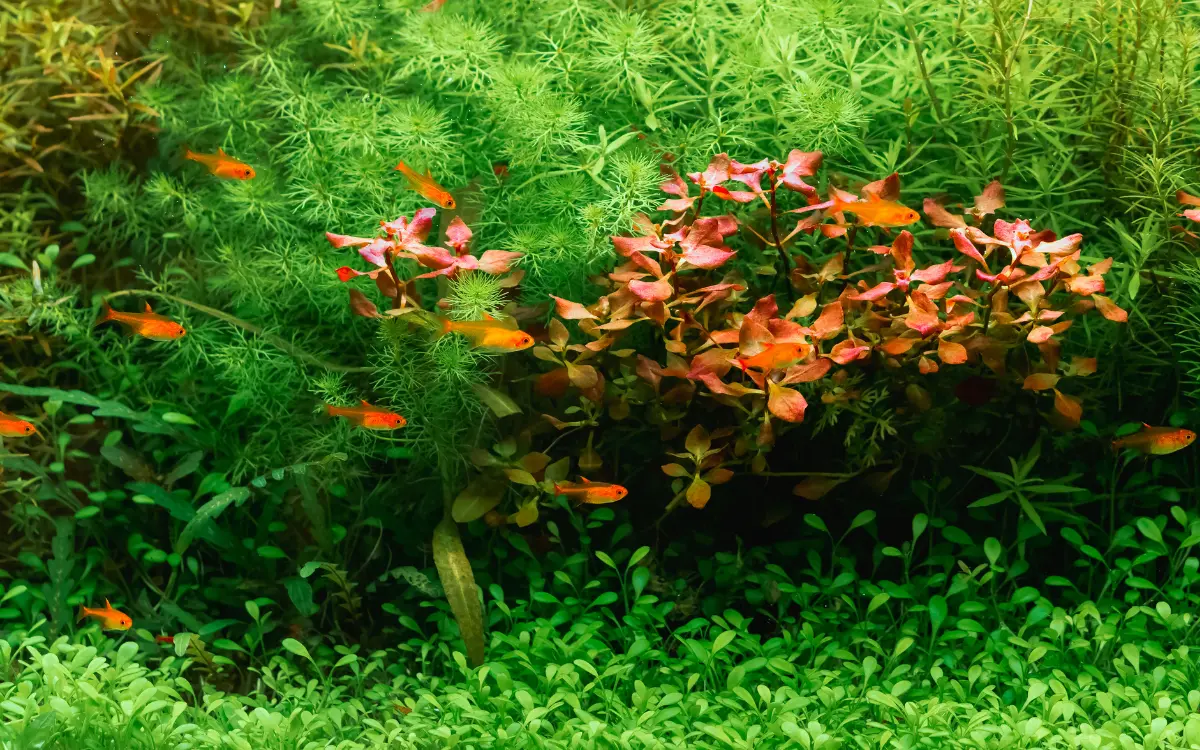Aquarium plants are like the trees and flowers you see in a garden, but they live underwater.
These plants are an important part of an aquarium because they help keep the water clean and provide a natural home for fish.
Types of Aquarium Plants
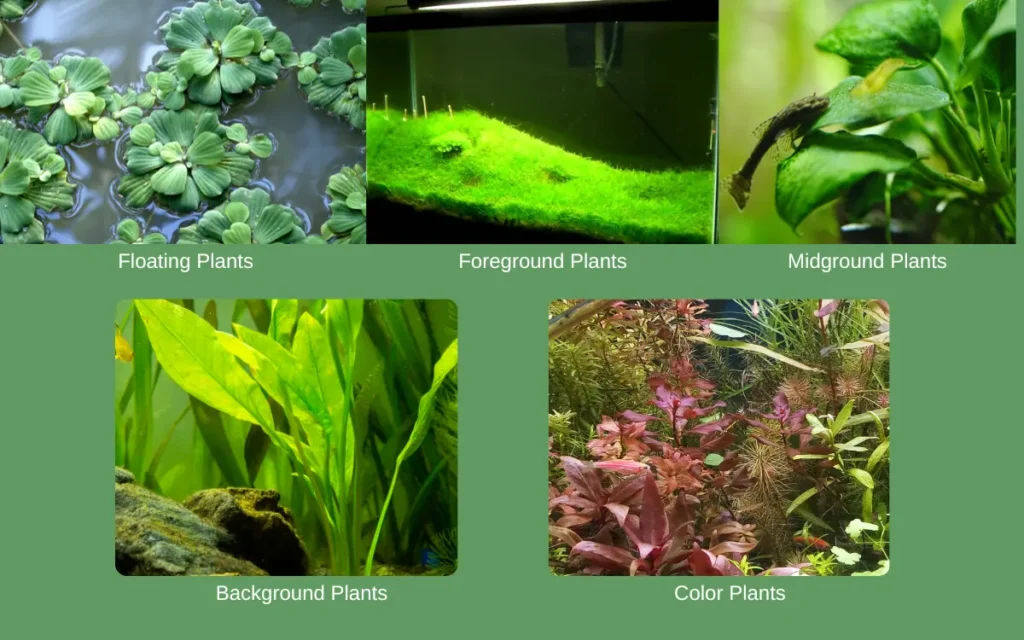
There are different types of aquarium plants, including floating plants, foreground plants, midground plants, background plants, and red plants. Let’s explore each type!
1.Floating Plants:
Floating plants are plants that float on the surface of the water. They don’t need to be planted in the gravel. Examples include Duckweed and Water Lettuce. They provide shade and help keep the water clean.
2.Foreground Plants
Foreground plants are small plants that grow at the front of the aquarium. They create a carpet-like effect on the bottom of the tank. Examples include Dwarf Hairgrass and Java Moss.
3.Midground Plants
Midground plants are medium-sized plants placed in the middle of the tank. They help fill the space and create a natural look. Examples include Anubias and Cryptocoryne.
4,Background Plants
Background plants are tall plants that grow at the back of the aquarium. They create a lush backdrop for your tank. Examples include Amazon Sword and Vallisneria.
5.Color Plants
Color plants add vibrant colors to your aquarium, making it look lively and beautiful. They can be red, purple, or other bright colors. These plants need special light to keep their colors bright. Examples include Red Ludwigia and Purple Cabomba.
Planting and Maintenance
Planting aquarium plants is easy. Place the roots in the gravel or sand, and make sure they are secure. For floating plants, just place them on the water’s surface.
Maintenance Tips:
- Light: Ensure plants get 8-10 hours of light daily.
- Nutrients: Add special plant food to the water.
- Water: Change some water weekly to keep it clean.
- Trimming: Trim plants regularly to keep them healthy and neat.
Aquarium Plants without CO2
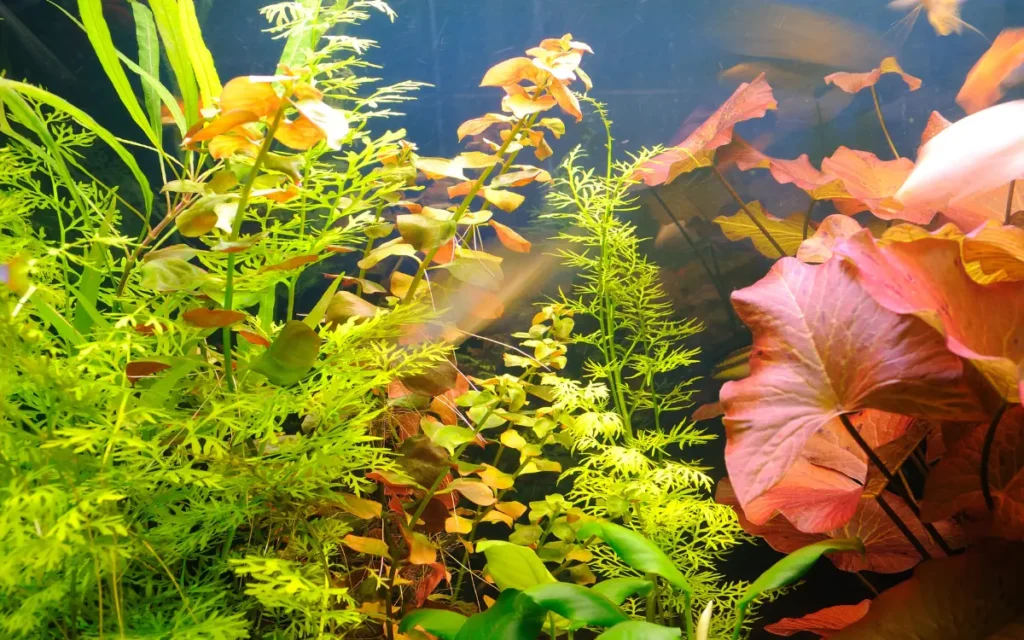
| Plant Name | Amount Per Gallon | Light Requirement | Growth Rate | Suitable Fish |
| Anubias | 1-2 plants | Low | Slow | Tetras, Betta, Gourami |
| Java Fern | 1-2 plants | Low | Slow | Guppies, Mollies, Plecos |
| Cryptocoryne | 2-3 plants | Medium | Moderate | Angelfish, Discus, Barbs |
| Amazon Sword | 1 plant | Medium | Fast | Cichlids, Tetras, Gourami |
| Vallisneria | 2-3 plants | High | Fast | Rainbowfish, Danios, Barbs |
| Hornwort | 2-3 stems | Low | Fast | Livebearers, Rasboras, Tetras |
| Java Moss | 1-2 clumps | Low | Slow | Shrimp, Betta, Small Tetras |
Aquarium Plants that Need CO2
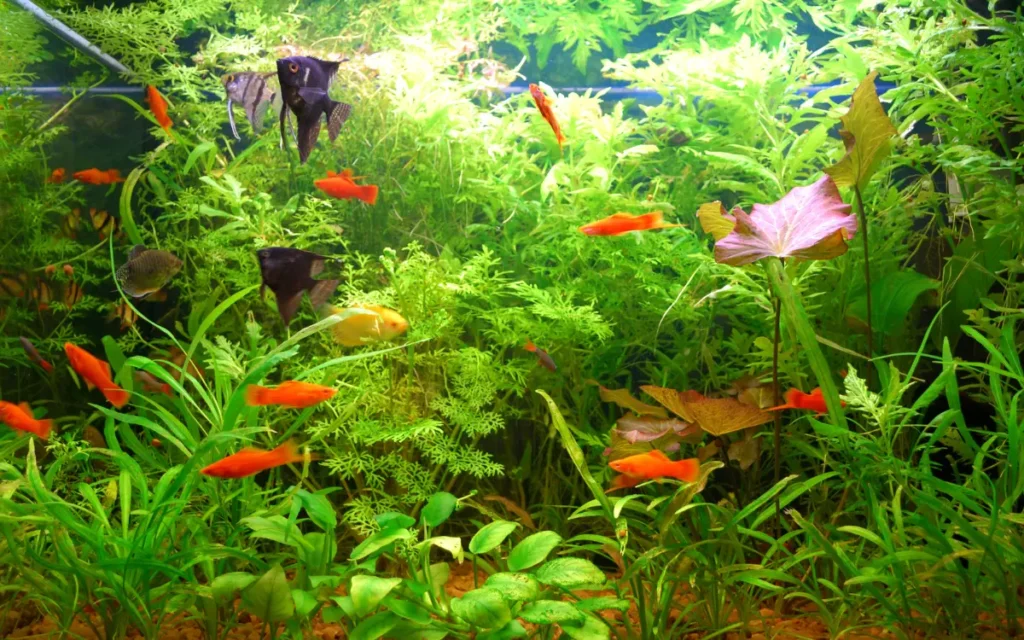
| Plant Name | Amount Per Gallon | Light Requirement | Growth Rate | Suitable Fish |
| Glossostigma | 1-2 plants | High | Fast | Tetras, Rasboras, Shrimp |
| Dwarf Baby Tears | 2-3 plants | High | Fast | Guppies, Neon Tetras, Shrimp |
| Red Ludwigia | 1-2 plants | Medium to High | Moderate | Angelfish, Discus, Gourami |
| Rotala Rotundifolia | 2-3 plants | High | Fast | Livebearers, Danios, Barbs |
| Alternanthera Reineckii | 1-2 plants | Medium to High | Moderate | Betta, Tetras, Dwarf Cichlids |
| Monte Carlo | 2-3 plants | High | Fast | Small Tetras, Shrimp, Rasboras |
| Bacopa Caroliniana | 1-2 plants | Medium to High | Moderate | Gourami, Mollies, Barbs |
Choosing the Right Plants for Your Aquarium
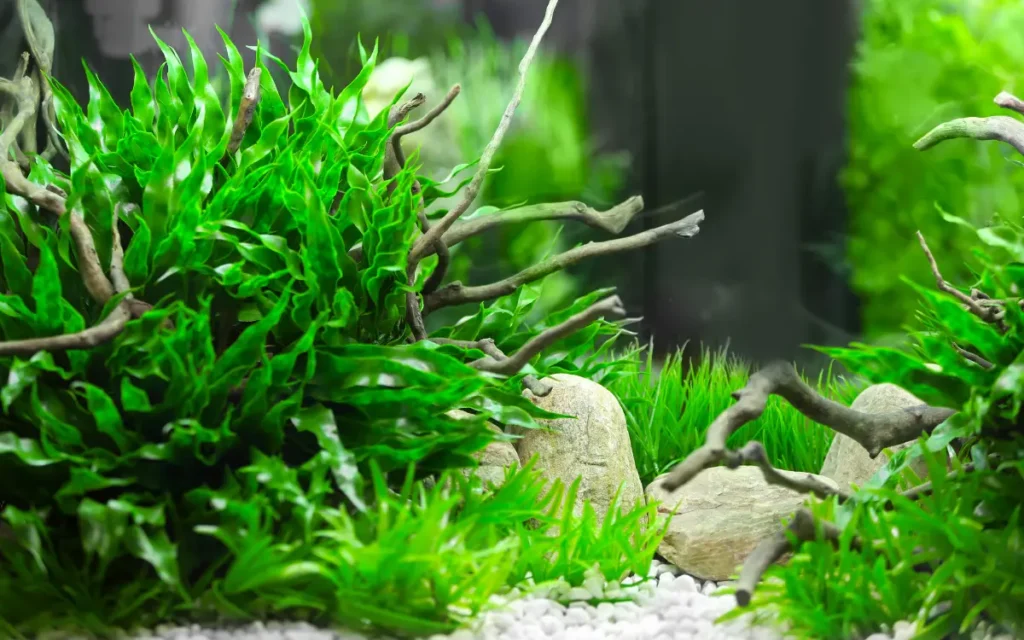
Freshwater Aquariums
- Best Plants: Anubias, Java Fern, Amazon Sword, Cryptocoryne
- Light Requirement: Low to Medium
- Special Care: Regular trimming, nutrient-rich substrate
Saltwater Aquariums
- Best Plants: Turtle Grass, Manatee Grass, Halimeda
- Light Requirement: Medium to High
- Special Care: Salt-tolerant plants, stable salinity levels
Brackish Water Aquariums
- Best Plants: Java Fern, Anubias, Vallisneria
- Light Requirement: Low to Medium
- Special Care: Adaptable plants, monitor salinity levels carefully
Common Issues and Solutions
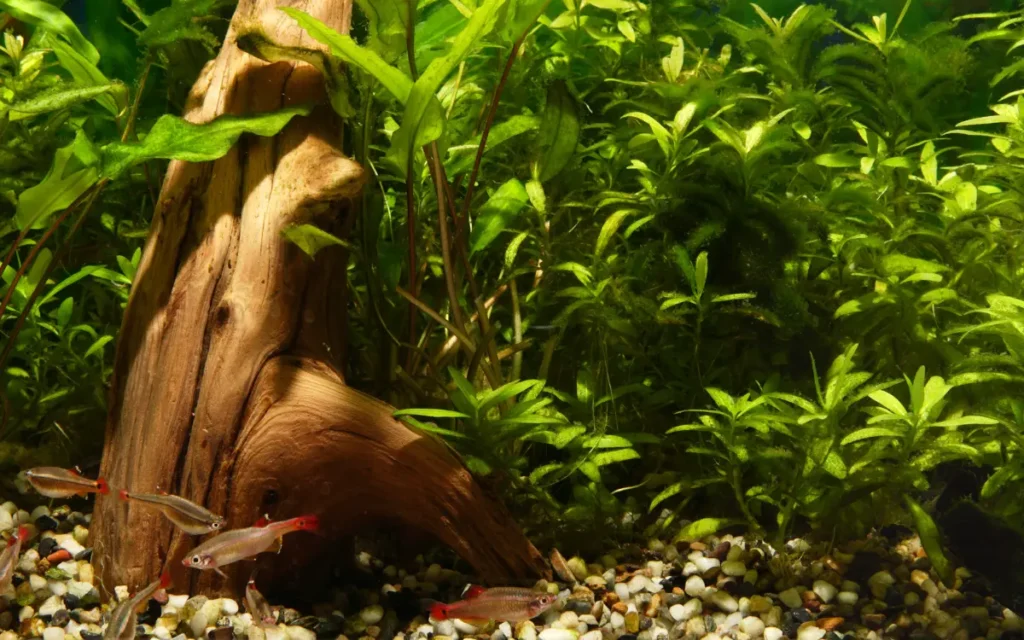
1. Algae Growth
- Issue: Algae can grow quickly and cover plants.
- Solution: Reduce light exposure and add algae-eating fish or snails.
2. Yellowing Leaves
- Issue: Leaves turn yellow and die.
- Solution: Check for nutrient deficiencies and add plant fertilizers.
3. Plant Melting
- Issue: Plants appear to dissolve or melt away.
- Solution: Ensure proper acclimation to water conditions and maintain consistent temperature and pH levels.
4. Slow Growth
- Issue: Plants are not growing as expected.
- Solution: Increase light intensity and consider adding CO2 if needed.
5. Floating Plants Not Staying in Place
- Issue: Floating plants move around too much.
- Solution: Use plant weights or gentle current to keep them in one area.
Aquascaping with Plants Ideas
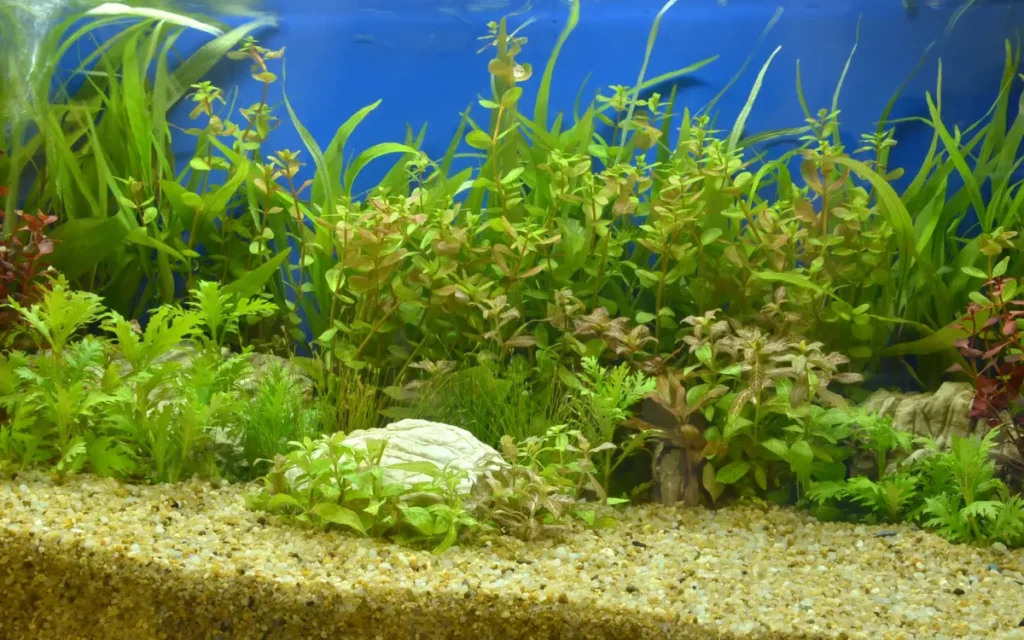
Aquascaping is the art of arranging plants, rocks, and decorations in an aquarium to create a beautiful underwater landscape. Here are some tips for aquascaping with plants:
1. Plan Your Layout
- Foreground: Use small plants like Dwarf Hairgrass for the front.
- Midground: Place medium-sized plants like Anubias in the middle.
- Background: Use tall plants like Vallisneria at the back.
2. Create Depth
- Arrange plants in layers, from shortest to tallest, to create a sense of depth.
- Use rocks and driftwood to add height and structure.
3. Use Color and Texture
- Mix different colors and textures to make the aquascape interesting.
- Combine green plants with red plants like Red Ludwigia for contrast.
4. Maintain Balance
- Ensure the plants are balanced on both sides of the tank.
- Avoid overcrowding plants to give each one enough space to grow.
5. Regular Maintenance
- Trim plants regularly to maintain the desired shape.
- Remove any dead or decaying leaves to keep the tank clean.
FAQs
What are the best aquarium plants for beginners?
Some of the best aquarium plants for beginners include Anubias, Java Fern, and Amazon Sword. These plants are hardy and easy to care for.
Do aquarium plants need special lighting?
Yes, most aquarium plants need specific types of light to grow well. Low light plants need less intense lighting, while high light plants require stronger light for proper growth.
Can I grow aquarium plants without CO2?
Yes, many aquarium plants can grow without CO2. Plants like Anubias, Java Fern, and Cryptocoryne are suitable for low-tech setups without CO2 injection.
How do I plant aquarium plants in gravel?
To plant aquarium plants in gravel, gently push the roots into the gravel and cover them. Make sure the roots are well secured and the plant base is above the gravel.
What are the disadvantages of live plants in an aquarium?
Live plants require regular maintenance, can introduce pests or algae, and sometimes need specific water conditions to thrive.
How do I add plants to an aquarium with fish?
When adding plants to an aquarium with fish, gently place the plants in the desired location. Ensure the plants are secure and won’t be uprooted by the fish. It’s best to do this during a water change to reduce stress on the fish.
How can I grow aquarium plants from seeds?
To grow aquarium plants from seeds, spread the seeds on the substrate and cover them lightly with a thin layer of gravel or sand. Keep the water temperature and lighting conditions optimal for germination.
Can aquarium plants grow without soil?
Yes, some aquarium plants can grow without soil. Floating plants like Duckweed and attached plants like Java Fern can thrive without being rooted in soil.
How often should I fertilize aquarium plants?
Fertilize aquarium plants weekly with liquid fertilizers or use root tabs for rooted plants. Adjust the frequency based on plant growth and water parameters.
How do I prevent algae growth on aquarium plants?
To prevent algae growth, avoid overfeeding fish, maintain proper lighting duration (8-10 hours a day), and perform regular water changes. Adding algae-eating fish or snails can also help control algae.
Does Sunlight Create Algae?
Yes, sunlight can create algae in an aquarium. Algae thrive on light, and too much sunlight can lead to excessive algae growth. To prevent this, keep your aquarium away from direct sunlight and use controlled artificial lighting instead.

